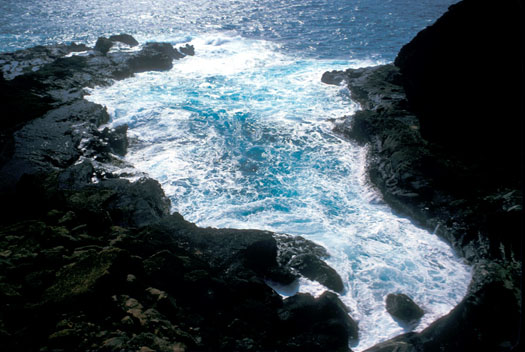
I use “Kokohead” to describe three shore diving sites I would go to occasionally along the rugged lava coastline bordering the old volcano Koko Head between Hanauma Bay and Sandy Beach on Oahu. All three of these sites could be quite rough at times, and should be attempted only when the surf is low.
Blowhole is the best known. It is the easternmost of these sites, right next to Sandy Beach, a well-known body surfing beach. The beach was also well known for body surfing injuries. You could see quite a few neck braces around the University of Hawaii campus that were attributed to Sandy Beach.
At Blowhole, you could park in the lot for the Halona Point Blowhole, a popular tourist attraction. On the western side of the lot was a pathway down to a small beach in a cove where it was relatively easy to get in and out of the water. However, if the surf was up, it could be kind of tricky getting into and out of the cove itself. Diving there, I would usually either bear off at about a 45 to 60 degree angle to the right after coming out of the cove to get to some reefs just off shore. Or if it was calm enough, I would follow the coastline itself off to the right where sheer cliffs along the shore dropped right down into the water. There were some interesting sponge-covered walls and crevices here. But you had to watch for fishhooks. Fishermen were often working from the rocks high above.
The westernmost of these three sites was at Lanai Lookout, another parking lot where you could look out across Molokai Channel to see the islands of Molokai and Lanai in the distance. Again, a pathway down to a small cove on the right side of the lot was the best way to enter the water. There was no beach, but the cove was relatively calm at times.
About halfway between these lookouts was another narrow gorge that we called the Pit, for reasons I won't go into here. In the photo below, the Pit is the cove in the dead center.

We'd park a few meters past the small bridge that crossed the gorge in a small pullout off the road, walk back to the bridge, and climb down to the water's edge in full gear. There wasn't much of a path here, but it was not too difficult. The next photo shows the cove from the path going down to it.

It was easy to jump into the water over on the left side not quite out at the mouth of the cove. Getting out of the water was trickier. The wall was sheer enough that the waves did not usually break too badly in the cove, but it was often full of foam making it difficult to see in the water. The water level along the edge would rise and fall as the swells came in. Getting out usually involved removing your fins and looping them on your arms and waiting on the surface by the wall for a swell to lift you up. The wall here was pocketed with urchin holes, mostly short-spined urchins but some with long sharp spines. At the high point of the swell, you grab the wall with your hands and toes (hoping you miss the urchins) and hang on for dear life while the water level drops as the swell passes. If you managed to retain your grip and not get pulled back into the water, you'd scramble up onto the reef flat quickly, before the next swell came along to knock you off. Yes, I admit I was a bit insane in my earlier years.
These were not especially rich areas, but there were quite a few Glossodoris rufomarginata and Hypselodoris peasei along the cliff west of the Blowhole and I saw a number of H. violabranchia at the Pit.
Close tab when finished.